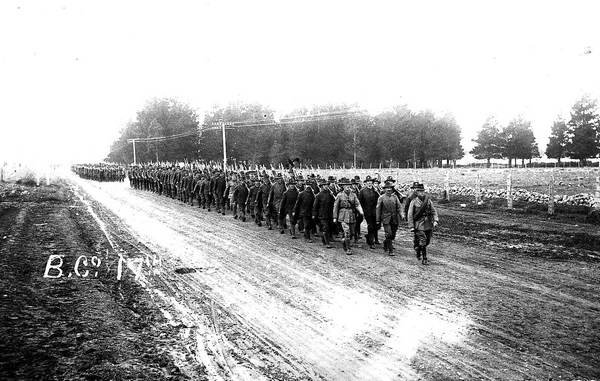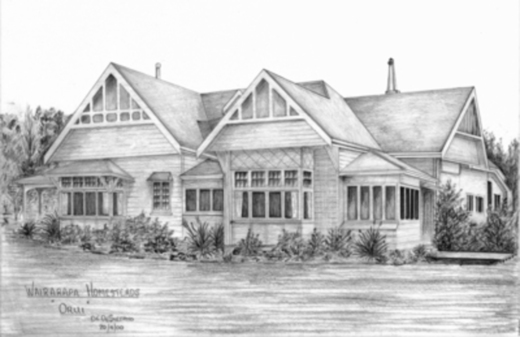Featherston Military Camp
B Company, 22nd reinforcements, on the Rimutaka Hill, 1917. The men are wearing toitoi on their hats. 00-38/16.digital
In January 1916 the biggest
army training camp in New Zealand opened in Featherston. The camp
occupied the land on both sides of the main road between Featherston and
Tauherenikau. In 1916 the camp was the biggest settlement in the
Wairarapa at a time when Masterton’s population was 5,500. It covered
almost 30 hectares. Today there is only a memorial to the camp by State
Highway 2.
Before
Featherston Camp began, there was a smaller camp at Tauherenikau, used
by the army in 1911. When World War One began in August 1914, most hoped
the war would not last very long. By the end of 1915 after the
Gallipoli Campaign, it was clear that fighting would continue for some
time and there was a need for more trained soldiers. Trentham Camp in
the Hutt Valley was overcrowded and a new site with ample space was
chosen at Featherston.
The permanent
accommodation of the camp was designed and built between August 1915 and
January 1916 by a workforce of 1000 men. 30 tonnes of nails were used
on the 250 buildings. The camp was lit by electric generators and used
the latest design for the 90 barrack buildings. Water to the camp was
carried through 10 kms of steel pipes and there was 5 kms of roading.
A railway line
was laid from Featherston so large quantities of supplies could be
easily transported to the camp. A hospital, shops, chapels, the YMCA
(Young Men’s Christian Association) and an officers’ club were also
built, mostly along the main Featherston-Masterton road. Accommodation
for the many horses needed by the army was at the camp’s eastern end,
near the Tauherenikau River.
There were
several smaller camps attached to the main camp. Papawai Camp near
Greytown was a training camp for shooting and for specialist groups such
as signallers. Canvas Camp (a tent area) was set up on the south side
of the road, and C.1 Camp at Tauherenikau was for men classed as unfit.
There they received physical training to become fit and healthy enough
for overseas service.
The whole camp
could house about 8000 men at a time, at different stages of training.
Soldiers who had almost completed training would move to Canvas Camp so
they would be ‘toughened’ for real war. Each large group of men coming
into the camp was called a ’reinforcement’ , When each numbered
reinforcement was trained, the whole group marched over the Rimutaka
Hill road to Trentham Camp before leaving on ships for Europe.
Featherston people would offer tea and food to the soldiers at the
summit.
The training
period at Featherston was from two to four months, depending on the type
of soldier. They learned to march, dig trenches, fire their rifles,
machine guns and artillery cannon, manage horses, obey orders quickly,
and to live together in large groups. Most men trained as infantry (foot
soldiers) but others trained as stretcher bearers, signallers,
engineers, gunners, drivers, cooks and clerks. Featherston was the main
New Zealand camp for artillery, mounted rifles and specialist troops.
Feeding such a
large number of men was a big job. There were 16 dining halls and the
men ate simple but wholesome food. Most soldiers gained weight because
of regular food and exercise. A typical menu for the day was:
Breakfast - Mince and potatoes, porridge, bread, butter and tea
Lunch - Bread, butter, jam, cheese and tea
Dinner - Roast beef, potatoes, suet pudding
Soldiers
were allowed out of camp and the camp shops provided extra services
such as bath houses, boot repairs, photography, clothing and a variety
of food. Some prominent South Wairarapa people decided the soldiers
should have a place to go away from the camp and they raised the money
to build the Anzac Club (now Anzac Hall) in Featherston. This offered
reading and writing rooms, a concert hall, billiard tables, card tables,
baths and a cafeteria – a home away from the camp. Races at
Tauherenikau Racecourse were very popular with the soldiers.
In the early
20th century most people belonged to a church so some of the main
churches, including Anglican, Catholic and Salvation Army, set up
chapels at the camp for the soldiers. There was also the YMCA soldiers’
club. Gardens and lawns were laid to make the camp more pleasant for the
men.
When the Great
War (now called World War One) ended in November 1918, the camp was
still full of soldiers under training. The world-wide influenza pandemic
arrived in New Zealand and was carried into Featherston Camp. Many
soldiers became ill and before the ‘flu was over, 177 had died.
The
Anzac Club and barracks became temporary hospitals for the sick soldiers
as the proper hospital could not cope with the numbers.
After the war,
the large camp was no longer needed. The buildings were often relocated
and occasionally can still be seen around Wairarapa. Part of the
soldiers’ club became the Kahutara Hall and was shifted in 1921.
A small camp
was built in 1942 for Japanese prisoners of war, captured in the Pacific
campaign. Concrete foundations of a few World War Two buildings can
still be seen across the road from the memorial.
Main Street of the Featherston Camp, which was also the Masterton-Featherston road, showing shops, and the clock tower of the Salvation Army Institute. 00-38/3.digital
Huts at the Featherston Camp, probably taken from the northern end, looking south, 1916-18. 00-38/10.digital
Featherston Camp barracks, 1916-18 - 00-38/20.digital 00-38/20.digital
Soldiers lined up in front of the barracks for a gear inspection, Featherston Camp, 1916-18 00-38/6.digital
Soldiers marching through the Featherston Military Camp, led by a band. The railway line branch from Featherston can be seen to the left. Shops attached to the camp line the right hand side of the Featherston-Masterton road. 00-38/14.digital
The church institutes provided soldiers with somewhere to relax, write letters and play indoor games, as well as concerts and church services. This photo shows the Catholic Institute, Salvation Army Institute (before its clocktower was added in mid-1917), and Church of England Institute, c1917. The United Institute stood behind these buildings. (Stanbrook) 11-174/3-2.digital
Another view of the church institutes, showing the clock tower on the Salvation Army Institute. 91-055/54B.R3B1S6
Mr and Mrs Weber, with others, at the Featherston Camp, with the Salvation Army Institute (partly obscured) in the middle of the picture, and the Church of England Institute to the right. 91-49/22.R3B1S4
Main Street, Featherston Military Camp showing the shops and part of the Canvas Camp tents in the background. 00-38/19.digital
Photo shows horses being led in a stabling area of the Featherston Camp. 98-231/34.R6B5S7
44th NCO class on horseback, probably near Featherston Camp, circa 1916-18 04-86/9.digital
Group of soldiers - hut mates from the 14th Reinforcement. Colin Algie is fourth from the right in the back row. 04-86/13.digital
Soldiers eating outdoors. Most have tin mugs and lemon squeezer hats are in evidence. 00-38/5.digital
Group of soldiers taking leave from the Featherston Camp in a Garford bus owned by L G Pearce, of Greytown. 04-173/5.digital
Mess orderlies from the Featherston Camp on top of the Rimutaka Hill, 1916-18. They are carrying Lee-Enfield rifles. 00-38/29.digital
Military hospital, Featherston Military Camp. 98-231/19.R6B5S7
Further photographs are available here
The Government demolished the camp in 1926, although the site was re-used to house Japanese prisoners of war from 1942-1945.
---
Sources and further reading:
Safe Haven: The Untold Story of New Zealand's Largest Ever Military Camp:Featherston: 1916-1919, by Neil Frances
Featherston Military Camp and the First World War, by Tim Shoebridge, for Manutu Taonga, the Ministry of Culture and Heritage.
Featherston Military Training Camp, Wairarapa Archives
NZ History Online: Featherston Camp (Ministry of Culture and Heritage)
Wairarapa Archives (photographs)
Unless specifically attributed, all photographs are from Wairarapa Archives.










Comments
Post a Comment